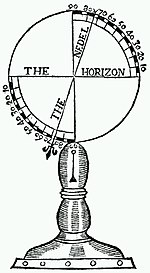This article relies largely or entirely on a
single source. (July 2021) |

Robert Norman was a 16th-century- English mariner, compass builder, and hydrographer who discovered magnetic inclination, the deviation of the Earth's magnetic field from the vertical.
Work
Robert Norman is noted for The Newe Attractive, a pamphlet published in 1581 [1] describing the lodestone ( magnet) and practical aspects of navigation. More importantly, it included Norman's measurement of magnetic dip, the incline at an angle from the horizon by a compass needle discovered by Georg Hartmann in 1544. This effect is caused by the Earth's magnetic field not running parallel to the planet's surface. Norman demonstrated magnetic dip by creating a compass needle that pivoted on a horizontal axis. The needle tilted at a steep angle relative to the horizon line.
Magnetic inclination and local variations were known before Robert Norman, but his pamphlet had a greater influence than the earlier work[ citation needed].
The crater Norman on the Moon is named in his honour.
Writings
- Norman, Robert (1721) [First published in 1581]. The newe attractive: shewing the nature, propertie, and manifold vertues of the loadstone : with the declination of the needle, touched therewith under the plaine of the horizon (Reprint ed.).
See also
- William Gilbert
- History of geomagnetism
- List of geophysicists
- Shen Kuo, discoverer of magnetic declination
References
- ^ Published in London by Ballard. See Harré, R. (1981). Great Scientific Experiments. Phaidon (Oxford). pp. 49 – 56. ISBN 0-7148-2096-2.
This article relies largely or entirely on a
single source. (July 2021) |

Robert Norman was a 16th-century- English mariner, compass builder, and hydrographer who discovered magnetic inclination, the deviation of the Earth's magnetic field from the vertical.
Work
Robert Norman is noted for The Newe Attractive, a pamphlet published in 1581 [1] describing the lodestone ( magnet) and practical aspects of navigation. More importantly, it included Norman's measurement of magnetic dip, the incline at an angle from the horizon by a compass needle discovered by Georg Hartmann in 1544. This effect is caused by the Earth's magnetic field not running parallel to the planet's surface. Norman demonstrated magnetic dip by creating a compass needle that pivoted on a horizontal axis. The needle tilted at a steep angle relative to the horizon line.
Magnetic inclination and local variations were known before Robert Norman, but his pamphlet had a greater influence than the earlier work[ citation needed].
The crater Norman on the Moon is named in his honour.
Writings
- Norman, Robert (1721) [First published in 1581]. The newe attractive: shewing the nature, propertie, and manifold vertues of the loadstone : with the declination of the needle, touched therewith under the plaine of the horizon (Reprint ed.).
See also
- William Gilbert
- History of geomagnetism
- List of geophysicists
- Shen Kuo, discoverer of magnetic declination
References
- ^ Published in London by Ballard. See Harré, R. (1981). Great Scientific Experiments. Phaidon (Oxford). pp. 49 – 56. ISBN 0-7148-2096-2.